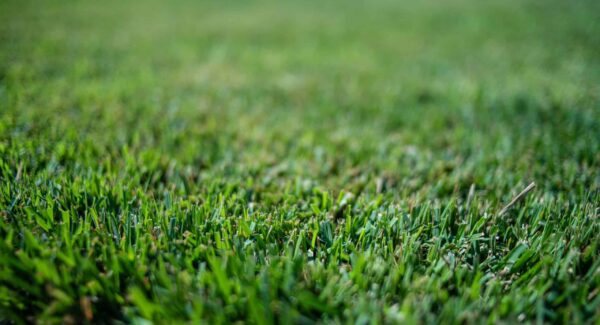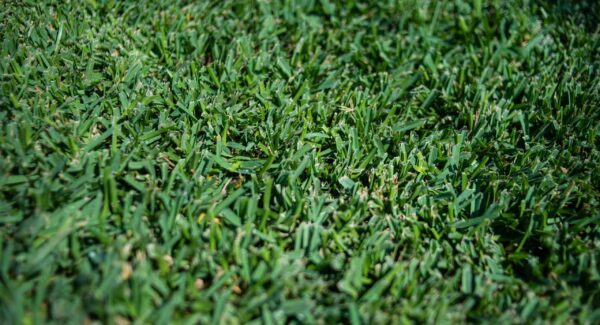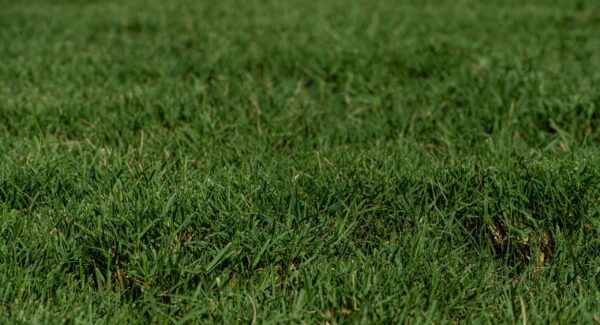Dormant Grass vs. Dead Grass: How to Tell the Difference
A lush, green lawn is undoubtedly the most beautiful sight in any yard, but there are times when brown patches appear, detracting from its appeal.
The most common causes of these brown, sparse spots on the lawn include water deficiency, fungal infections, poor mowing practices, or a lack of nutrients. Cutting the grass too short (scalping) and using dull mower blades damage it, making it weak and susceptible to diseases. A lack of nitrogen, iron, magnesium, or potassium can cause the grass to pale, yellow, or brown.
Prolonged periods of extreme heat and drought can stress the grass, leading to wilting, dormancy, or the appearance of brown blades. Lawn diseases and pests, such as fungal infections, can quickly damage the grass. Brown patches often appear defensive, allowing the grass to conserve water and prevent further damage.
These brown spots frequently prompt lawn owners to wonder whether the grass is dormant or dead, a common dilemma among lawn maintenance workers. Once you understand this distinction, you’ll avoid unnecessary stress and know which actions to take.
In this text, we will explore the differences between dormant and dead grass, which tests can help you identify the condition and practical recovery tips.
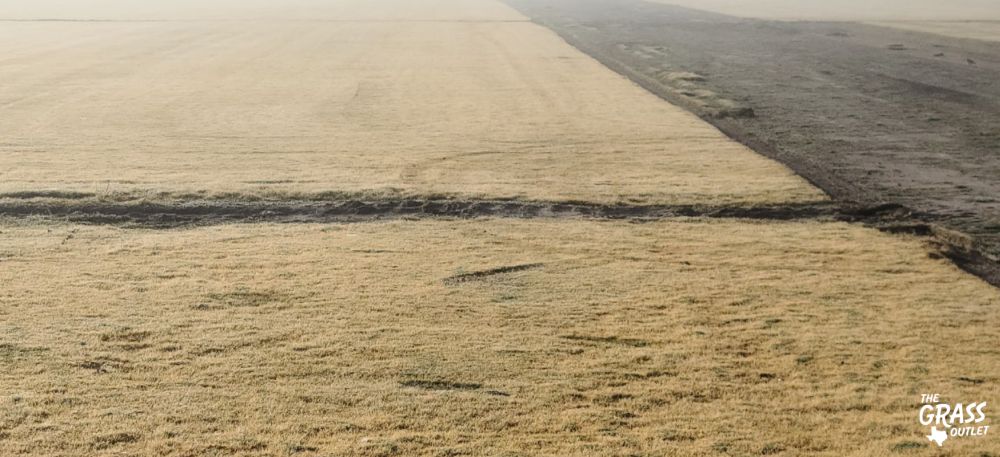
What is Dormant Grass?
Dormant grass is alive, but the dormant phase temporarily pauses growth to conserve energy during extreme weather conditions, such as drought or cold. The grass blades turn brown during this period, but the roots remain alive, storing water and nutrients until favorable conditions return.
When dormancy sets in, grass slows growth and preserves essential nutrients to thrive once external conditions improve. Dormancy occurs at different times of the year—during dry summers or cold winters—depending on the grass type and climate. Cool-season grasses enter dormancy during drought and high temperatures, while in winter, they slow growth and produce natural “antifreeze” to survive freezing temperatures.
Warm-season grasses, though more efficient in utilizing resources, can go dormant after the first or second frost. This dormancy allows them to conserve roots during colder periods.
Warm-season grasses, such as St. Augustine grass or Bermuda grass, often display unusual patterns as they transition into or out of dormancy. If your lawn shows consistent patterns of change across its surface, it’s a reassuring sign that the grass is still alive.
Cool-season grasses, like Kentucky bluegrass and Tall fescue, tend to take on a uniform brown or yellowish appearance during dormancy. A lack of noticeable variations in color across the lawn usually indicates that the grass is dormant, not dead.
Local climate conditions also influence dormancy, which typically begins when temperatures fall below 45°F or exceed 95°F for several consecutive days. This natural mechanism enables grass to withstand adverse conditions and maintain its health until optimal weather conditions return.
The duration of dormancy varies depending on the genetics of the grass type and its overall health. Most well-established lawns can survive drought-induced dormancy for up to 2-4 weeks without dying.
What Is Dead Grass?
Dead grass appears brown and lifeless, losing the green color and upright posture typical of a healthy lawn. Unlike dormant grass, dead grass cannot be revived or restored to its original state. It is often wholly brown, white, or grayish, with no signs of life. The blades are dry, brittle, and crumble under pressure, and the lawn remains flattened or breaks when pressed, showing no elasticity.
One way to identify dead grass is the so-called “tug test” – dead grass can be easily pulled out of the ground without resistance, indicating root failure. Additionally, dead grass shows no improvement even with proper watering and fertilization, and the issue persists despite efforts to address causes such as pests, watering, or diseases.
If the entire lawn has a uniform pale white-brown and brittle texture, it is almost certainly dead grass.
Why Does Grass Die?
Several factors can lead to grass dying, many of which can be prevented with proper lawn care and maintenance. Some of the most common causes include:
- Overwatering or underwatering can stress the grass and eventually lead to its death.
- Intense foot or vehicle traffic on fresh sod can damage the root system before it has a chance to establish itself.
- Brown patches often indicate fungal infections or other pests, which, if left untreated, can kill the grass.
- Without regular mowing, aeration, and fertilization, grass struggles to survive and grow.
Key Differences Between Dormant and Dead Grass
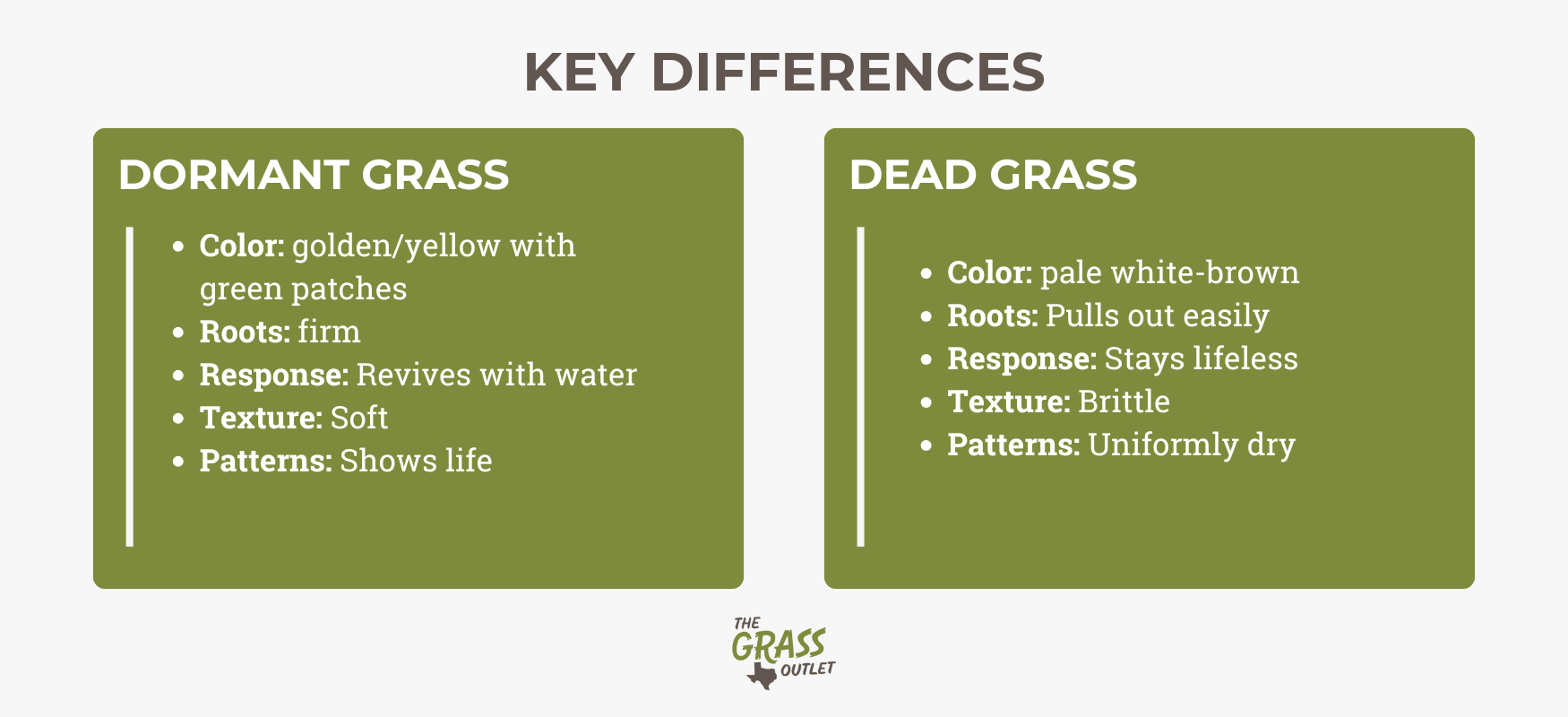
When a lawn begins to turn brown, it can be confusing for homeowners. The first thought often goes to the worst-case scenario—that the grass is dead, and it’s time for a complete lawn renovation. However, in many cases, the grass isn’t dead but dormant—a natural resting phase that helps it survive unfavorable weather conditions, such as drought or cold temperatures.
Distinguishing dormant grass from dead grass is essential so you know which care steps to apply. Here’s what to pay attention to:
Grass Color
Color is the first sign that can help you assess the condition of your lawn.
- Dormant Grass: It takes on a golden-brown or yellowish color but may retain patches of green, especially in more substantial areas, under favorable conditions.
- Dead Grass is completely pale white-brown or grayish and shows no signs of life, even in small sections of the lawn.
Root System
The root system provides a more reliable answer about the grass’s condition.
- Dormant Grass: The roots are firm and intact, and the grass is firmly in place.
- Dead Grass: The failed root system is easily identified with the “tug test”—dead grass effortlessly pulls out of the ground, indicating complete root failure.
Response to Watering
Proper watering is another clear indicator.
- Dormant Grass: With consistent watering and care, dormant grass will recover and regain its green color during warm months.
- Dead Grass does not respond to proper watering or fertilization and remains lifeless despite your efforts.
Grass Texture
The texture of the grass can reveal a lot about its state.
- Dormant Grass: Even though it may appear brown, it remains flexible and soft to the touch.
- Dead Grass: It feels dry and brittle and crumbles easily under pressure.
Overall Lawn Condition
Take a look at the entire lawn and observe any patterns.
- Dormant Grass: Browning is not entirely uniform; you may notice patches of green or areas where the grass still shows signs of life.
- Dead Grass has a consistent brown and brittle texture throughout the lawn, with no visible green or elasticity.
Response of Brown Spots to Care
Brown spots can look similar, but how they respond to care provides valuable information.
- Dormant Grass: Brown spots typically improve with lawn care, watering, addressing pests, or warmer weather.
- Dead Grass: Brown spots show no improvement, even after watering, fertilizing, pest control treatments, or consistent warm weather.
Tests to Identify Dormant vs. Dead Grass
There are several ways to determine whether your grass is dormant or genuinely dead.
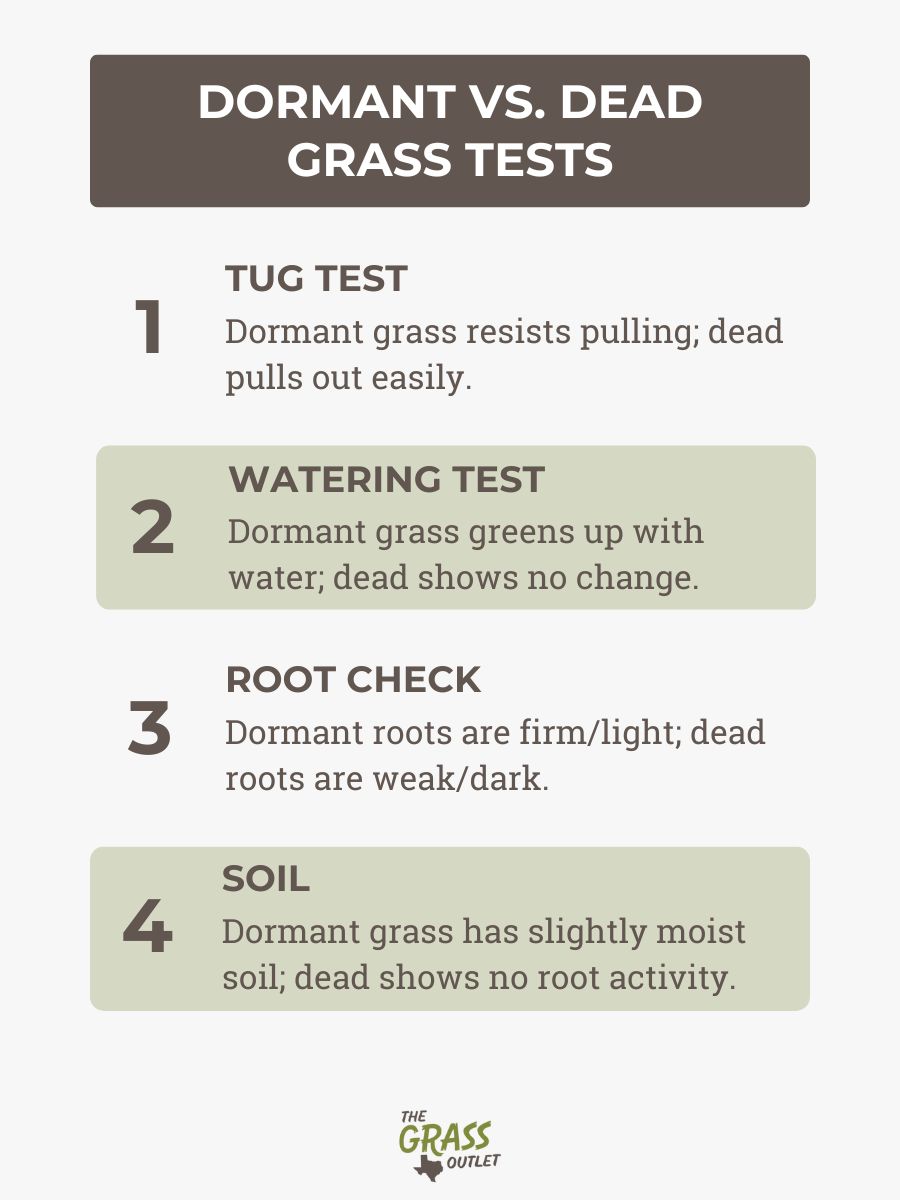
Here are a few methods:
Tug Test
The tug test is a quick and effective way to assess the condition of your lawn. Simply grasp a small section of grass near the surface and gently pull it upward.
- Dormant Grass: If the grass resists and remains firmly attached to the soil, it indicates dormancy, meaning the root system is still alive and intact.
- Dead Grass: If the grass and roots pull out easily without resistance, this is a clear sign that the root system has failed and the grass is no longer alive.
Watering Test
During the growing season (warmer months), there’s another simple way to determine the condition of your grass—just start watering.
Increase the watering for a few days, following the standard recommended weekly amount of 1 to 2 inches. Observe how the grass reacts.
- Signs of Recovery: If the grass begins to green up, refresh, and appear more vibrant, you can confidently conclude that it was dormant and that the extra care has helped.
- No Change: If the grass remains completely brown and shows no signs of life, it is likely dead.
Soil and Root Examination Test
Another reliable way to determine the condition of your grass is through a soil and root examination. This test involves carefully observing the root system and the surrounding soil where the grass grows.
Dig up a small section of your lawn, about 2-4 inches (5-10 cm) deep, including the roots and grass. The grass is dormant if the roots are firm, white, or light brown and cling well to the soil.
What about dead grass? The roots are weak, dark brown or black, rotting, and crumble easily under your fingers.
Check the soil moisture:
- Dormant grass: The soil may be dry or slightly moist, indicating temporary stress caused by a lack of water or unfavorable conditions.
- Dead grass: In the case of dead grass, the soil often remains unchanged, but the roots show no signs of life or the ability to absorb moisture.
How to Care for Dormant Grass
A lawn in dormancy is in a resting phase and particularly susceptible to damage, as its ability to regenerate is significantly reduced. Therefore, shifting your lawn care focus to protection is essential until favorable conditions return.
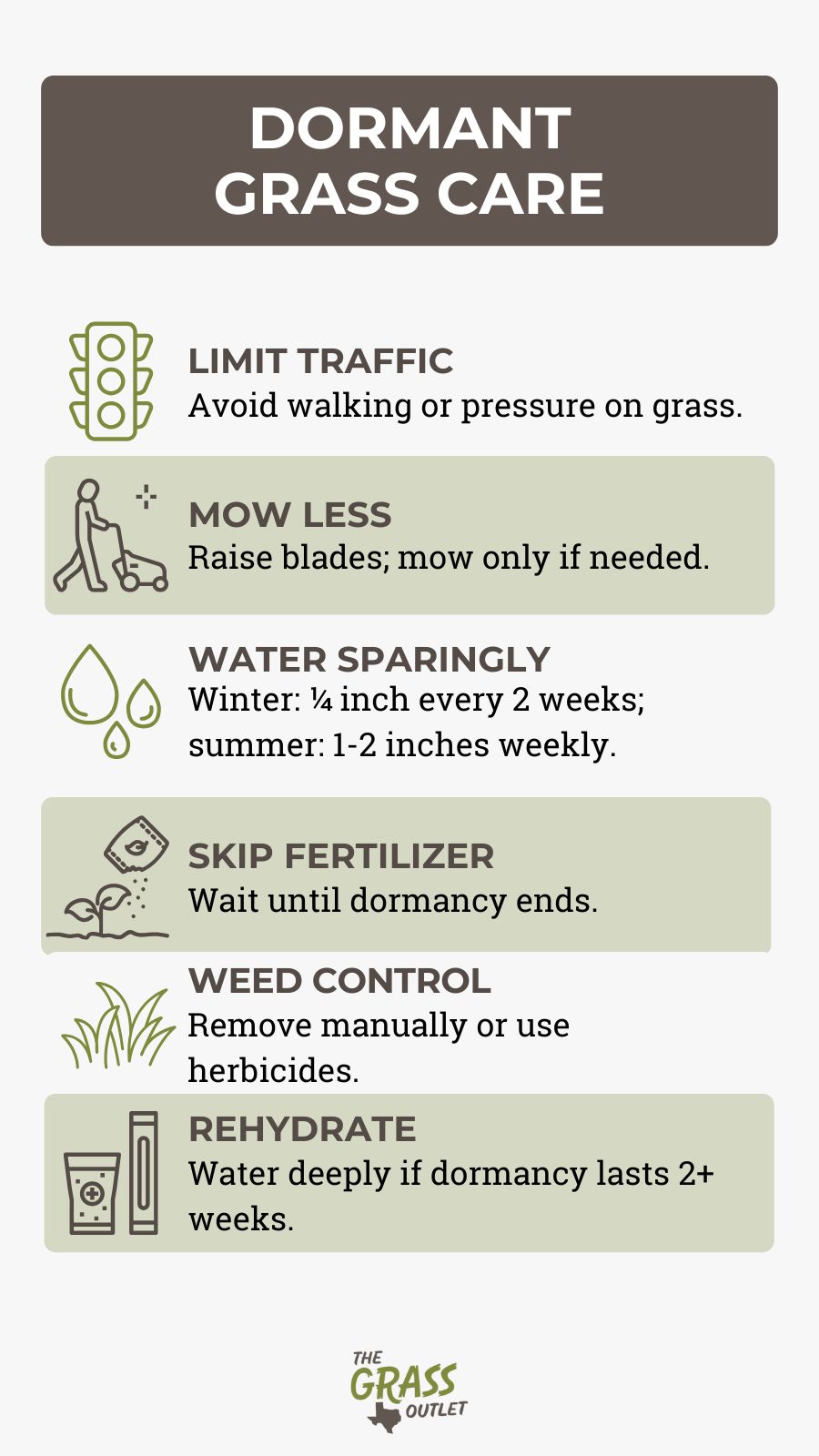
What should you do?
Minimize Foot Traffic and Lawn Stress
Dormant grass is delicate, and intense pressure can damage the roots or worsen its condition. Therefore, it is recommended that you limit walking, sports activities, and placing heavy objects on the lawn.
Mow Minimally and Only When Necessary
Mow only if the grass becomes too long, but raise the height of the mower blades to avoid additional stress and “scalping” the grass.
Keep Watering to a Minimum
During winter dormancy, water the lawn just enough to keep the roots alive—approximately ¼ inches of water every two weeks. Avoid overwatering, as excessive moisture can lead to fungal infections. If the grass is in stress-induced dormancy due to drought and heat, intervening with 1 to 2 inches of water weekly is critical.
Avoid Fertilization
Fertilizing during dormancy can stress the grass since its metabolism is inactive. Wait until the lawn comes out of the resting phase before applying nutrients.
Control Weeds
Weeds can grow aggressively while the grass is dormant. Remove weeds manually or use targeted pre-emergent herbicides (before the lawn enters dormancy) to prevent their spread.
Rehydrate the Lawn if Dormancy Persists for Too Long
If summer dormancy lasts longer than two weeks, rehydrate the lawn. Water it thoroughly so the soil is soaked to a depth of 4 to 6 inches. This may not immediately turn the grass green, but it will keep the roots alive and ready for recovery when weather conditions improve.
What to Do with Dead Grass
Before you start reviving dead grass, find the cause of its death. The causes can differ: drought, over-fertilization, fungal disease, pests, or poor maintenance.
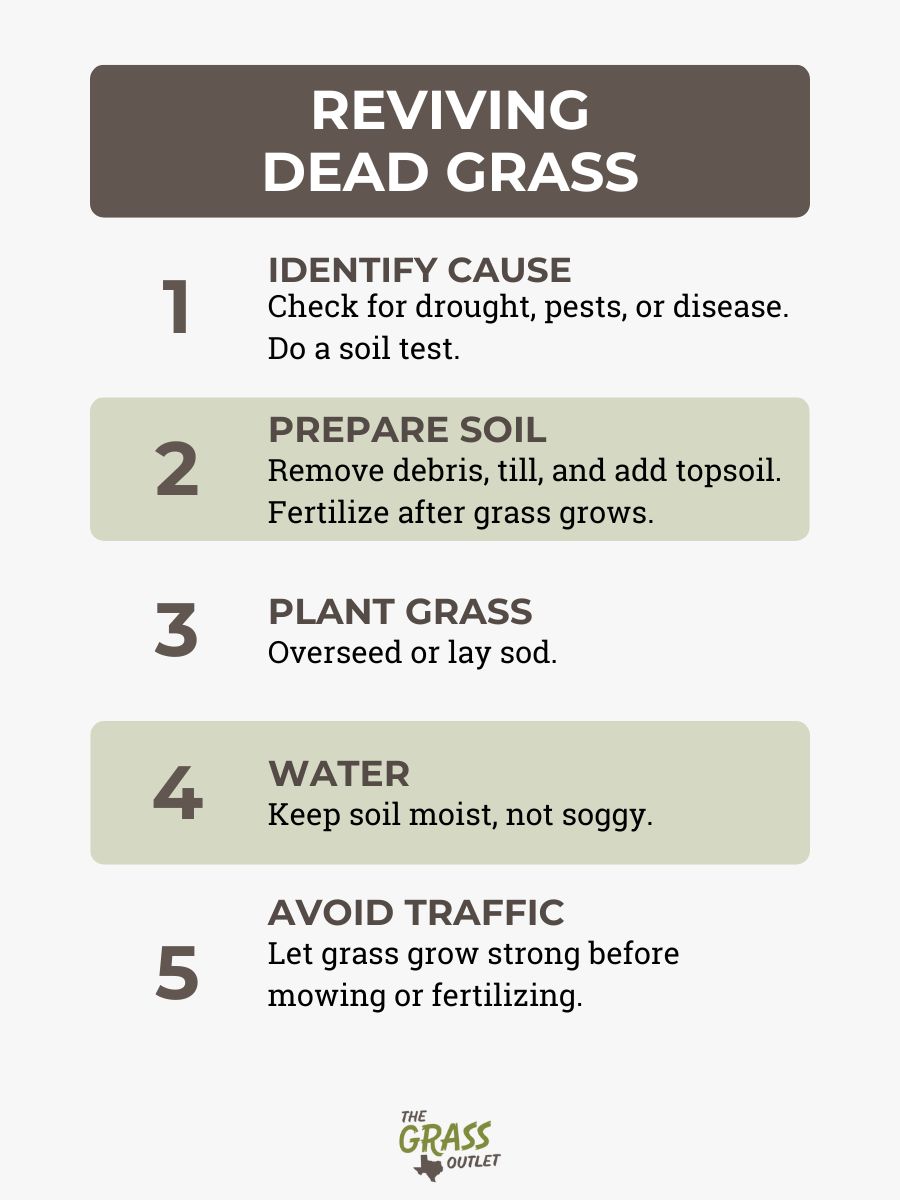
To determine this precisely, you should first troubleshoot for disease and pests. This flowchart will assist in troubleshooting, or you can call a local lawn care professional. You should also perform a soil test. This test will show the soil’s pH value and the levels of nutrients (nitrogen, phosphorus, and potassium), which will help you adjust fertilization and treatments.
Here are the steps for reviving dead grass:
- Use a rake or sod cutter to remove dead grass, stones, and plant debris. The soil must be clean so that new grass has room to grow.
- Till the soil to a depth of a few inches and add a few inches of fresh topsoil. This will enrich the soil and create a good base for new growth. The soil test will show you whether you need to add fertilizer – but apply fertilizer only after the new grass grows because, in the preparation phase, too many nutrients can cause the “burning” of the roots and leaves.
- Decide between overseeding or laying sod. If you choose to lay sod (a good solution for larger areas), The Grass Outlet is here to provide farm fresh sod.
- Keep the surface regularly soaked, especially in the first weeks. The soil should always be deeply wetted but not waterlogged.
- In the first few weeks, avoid walking on the restored lawn parts. Once the new grass strengthens, mow, but raise the blades to prevent excessive stress.
- When the grass has established deep roots and has been mowed at least once, you can safely apply customized fertilizer with the right balance of nitrogen, phosphorus, and potassium for your soil. This will help the young plants strengthen, stimulate root development, and accelerate recovery.
Preventing Grass Death and Prolonged Dormancy
Preventing dead grass and extending the growing season is all about consistent care and attention.
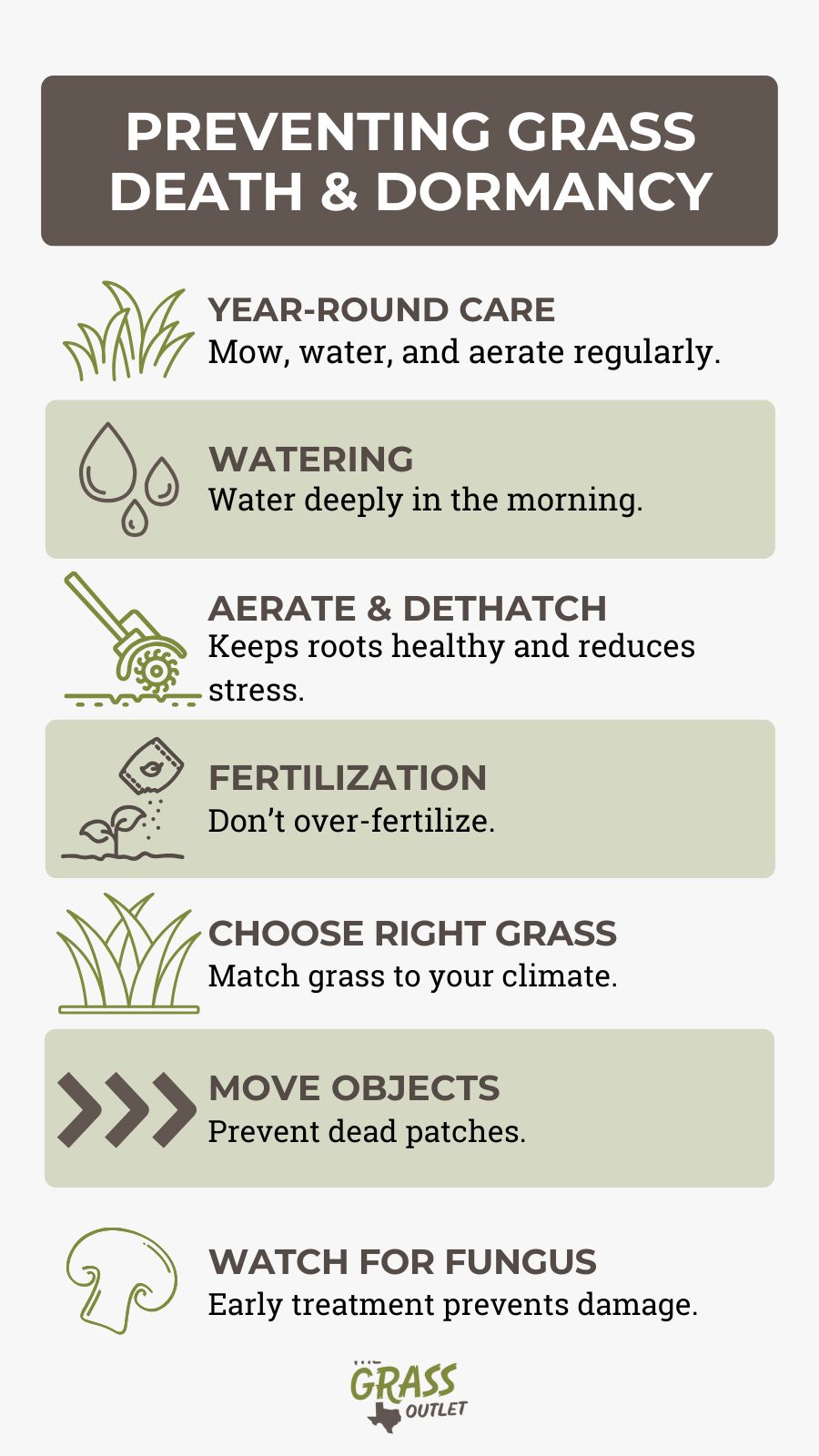
Here’s how homeowners can maintain a healthy lawn and avoid unnecessary stress that leads to dormancy or death:
Seasonal Lawn Care Tips to Avoid Stress
The key to a healthy lawn is year-round care. During the growing season, mow regularly, but avoid cutting the grass too short. This can weaken the grass, making it more susceptible to stress. Use sharp blades and clean the underside of your mower after each use to prevent the spread of disease.
Watering – Consistency is Crucial
Proper watering is essential for grass to thrive. Early morning watering is the best practice, giving the grass time to dry during the day and reducing the risk of fungal growth. Aim to water deeply but infrequently to encourage deep root growth. Underwatering can lead to shallow roots, which can cause the grass to go dormant faster.
Aeration and Dethatching
Regular aeration helps the soil breathe and allows water, air, and nutrients to reach the roots. Aeration every couple of years can significantly improve the health of your lawn. If thatch builds up on the soil’s surface, dethatching can help prevent the grass from suffocating and promote better growth.
Fertilization – Don’t Overdo It
Fertilizing the lawn is essential, but over-fertilizing can stress the grass and encourage fungal diseases. Always choose the right fertilizer based on your most recent soil test (we recommend yearly) and follow the manufacturer’s recommendations. Proper fertilization boosts growth, but too much can burn the grass and lead to poor health.
Choosing the Right Grass Type for Your Climate
The grass variety you choose plays a significant role in reducing the risk of dormancy. Cool-season grasses like fescue are ideal for cooler climates, as they thrive in spring and fall. For warmer climates, warm-season grasses like Bermuda, Zoysia, or St. Augustine are more suited, as they are drought-resistant and handle the heat better. Choosing the right grass will make your lawn more resilient and able to withstand the seasonal stresses that can cause dormancy or death.
Move Large Objects and Watch for Fungus
Large objects like trampolines, pools, or inflatable slides can leave patches of dead grass during summer. To avoid this, occasionally move these items around the yard to give your grass time to recover.
Keep an eye out for signs of fungal infections.
Early detection allows for quicker treatment, preventing further damage to your lawn.
Common Myths About Dormant and Dead Grass
The brown color of grass often causes panic, but it’s essential to know that this doesn’t necessarily mean the grass is dead. In many cases, brown grass is actually dormant – a natural survival mechanism that grass uses to protect itself from unfavorable weather conditions.
Dormancy is how grass adapts to extremes, such as drought, high temperatures, or low winter temperatures. In this state, the grass slows down its metabolism and redirects its energy to preserving the roots, allowing it to “rest” until favorable growing conditions return. Although the above-ground part of the grass is brown and lifeless, the roots remain alive and ready for regeneration.
Although it may look the same at first glance, dead grass and dormant grass differ because they stand more upright and look slightly more alive. With proper care, dormant grass can regenerate, whereas this is not the case with dead grass.
Conclusion
In lawn care, there will be times when grass enters dormancy and moments when it dies. It is important to recognize these situations and not panic.
Brown grass does not immediately mean it is dead; it might simply be dormant due to unfavorable weather conditions. Once external circumstances improve, the grass revives, or it may come back to life after watering if dormancy occurs due to high summer temperatures.
You can easily identify dead grass with the “pull test”—when you pull the grass from the ground, and it comes out easily, it indicates poor root health. Additionally, even after applying care, if the grass does not respond, it is a clear sign that it is dead.
Fortunately, following proper care guidelines can prevent grass from dying. Patience and time are key to maintaining a healthy lawn.
If you have any concerns or questions about this topic, feel free to contact The Grass Outlet. Our experts will be happy to assist you!
